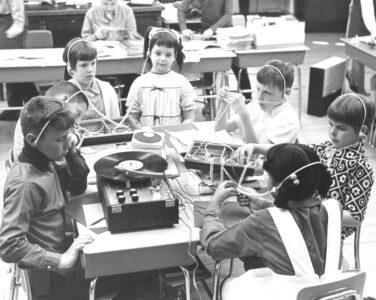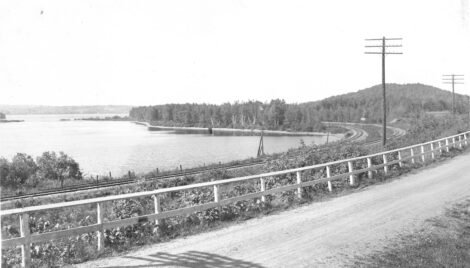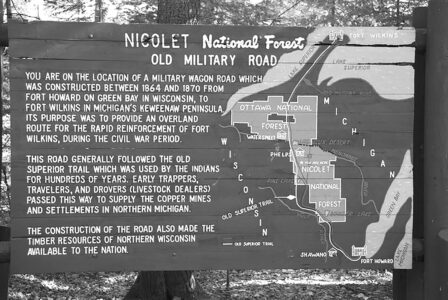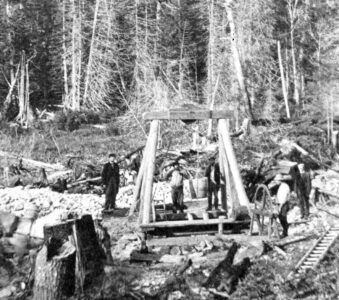Fire in Shaft No. 3: The Osceola Mine Fire Part 1

Bystanders gather outside Shaft No. 3 waiting for news of survivors. (Photo courtesy of Beth Gruber)
The Osceola Mine, owned by a Boston mining company, was located just outside Calumet, and was one of the more productive and profitable copper mines in the Copper Country, producing over 190 million pounds of copper and paying over $14 million in dividends to its investors (estimated at over $160 million today). In 1895 the mine had six shafts, the deepest was No. 4 at 32 levels (3,200 feet), while No. 3 had 30 levels (3,000 feet). The shafts were connected at various points by horizontal tunnels called drifts.
Saturday, Sept. 7, 1895 started off as a normal workday but would end in a fiery tragedy. Approximately 220 men, the entire day shift, were working underground. According to the official reports, smoke was first noted at the 27th level of No. 3 between 11:20 and 11:30 a.m., although two survivors testified that they knew of the fire at 10:45 and 11:05 a.m.
When the fire started, Captain Richard Trembath, the shift boss in charge underground, and a group of men began fighting the fire with buckets, while Captain Richard Edwards returned to the surface to get a hose and to report the fire. When Edwards attempted to return, the smoke had gotten too bad. At that point, he sent men down the shafts that were clear smoke to warn the miners and order them to come to the surface. At least one of these men did not return to the surface.
The miners reportedly did not appreciate the seriousness of the fire. Testimony at the inquest reported that some of the miners stopped to eat their lunch, while others stopped to smoke a pipe. One miner was quoted “there was no hurry, as there was not enough timber in the mine to make a good bonfire.”
Generally, drifts were protected from fires due to the lack of flammable materials like timbers, ladders and railroad ties.

the author’s great-great-grandfather, Thomas H. Curtis, who was one of 30 miners killed in the fire. (Photo courtesy of Beth Gruber)
At the inquest it was noted that the 27th level of shaft No. 3 was the only place in the mine where a fire of any magnitude could have started. Several months before, loose ground had been discovered in the area which was secured with timbers including a large amount of wood lagging (insulation).
As the fire grew No. 3 turned into a chimney for the smoke. Most of the men attempted to escape through No. 4, which should have been clear due to a down-draft drawing fresh air into the mine. Unfortunately, the smoke was sucked back into the mine, right into the faces of the escaping miners.
During the evacuation, they continued running the skips (buckets for hauling ore) slowly up and down the shafts so that survivors could jump in and be brought to the surface.
The men did not begin reaching the surface in considerable numbers until about 2 with the last man surfacing around 3 o’clock. Several relief parties attempted to enter the mine through the clearshafts but were driven back by the smoke and heat.
At 4:30 p.m., all hope for more survivors was lost and the shaft was sealed in an attempt to smother the fire. Even then, the smoke simply came out the other shafts, showing that the fire was still burning.
Eventually, a
- Bystanders gather outside Shaft No. 3 waiting for news of survivors. (Photo courtesy of Beth Gruber)
- the author’s great-great-grandfather, Thomas H. Curtis, who was one of 30 miners killed in the fire. (Photo courtesy of Beth Gruber)
Editor’s note: Next week’s article will cover the aftermath of the fire.
The names of the men who died:
Captain Richard Trembath, the shift boss
Richard Henry Bickle, miner
William Bryant, miner
John Cudlip, miner
Thomas H. Curtis, miner
Emil Walter Dahl, drill boy
Alexander Daniell, miner
William Henry Donald, miner
Richard T. Grenfell, miner
Isaac Harra, miner
James D. Harrington, miner
Bernard Hellner, miner
Robert Johns, miner
Michael Johnson, miner
Antoniego Juzwiak, laborer
Frank Lander Jr., drill boy
Peter Malstrom, trammer
Mike Matson, pumpman
Fred C. Peardon, miner
Mike Polchak, trammer
Joseph Rasimowicz, miner
Stephen Restovej, trammer
Andrew Rosinski, miner
Michael Schutte, miner
Joseph Slota, trammer and his brother
Michael Slota, trammer
Peter O. Strangaard, miner
Vence Verbenz, trammer
Michael Vok, trammer
James Williams, miner






